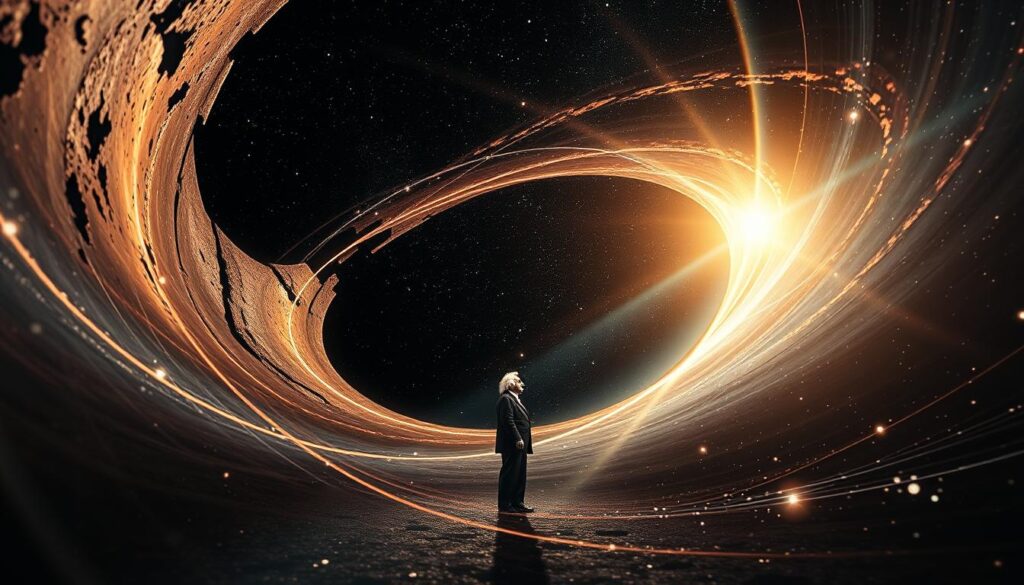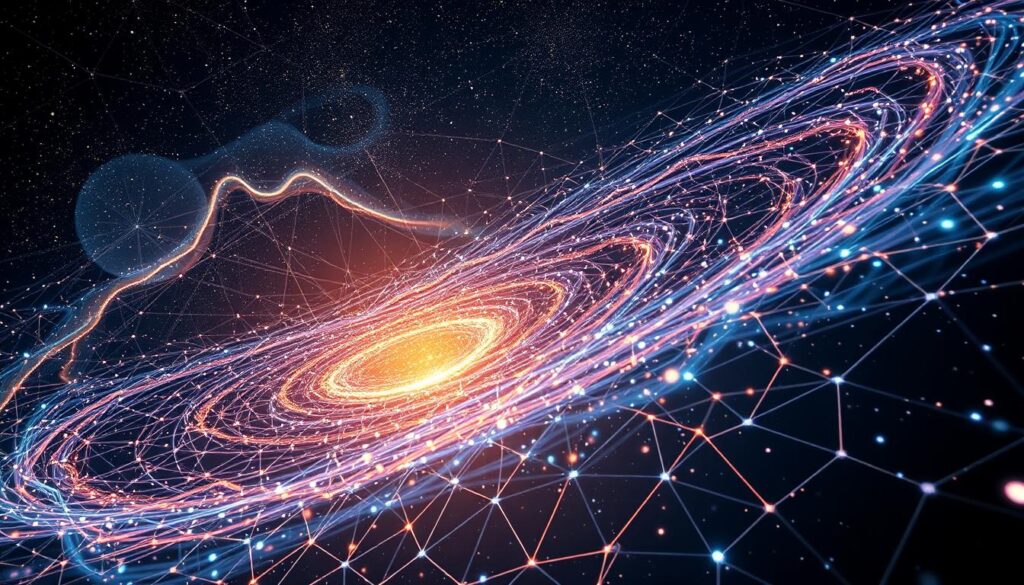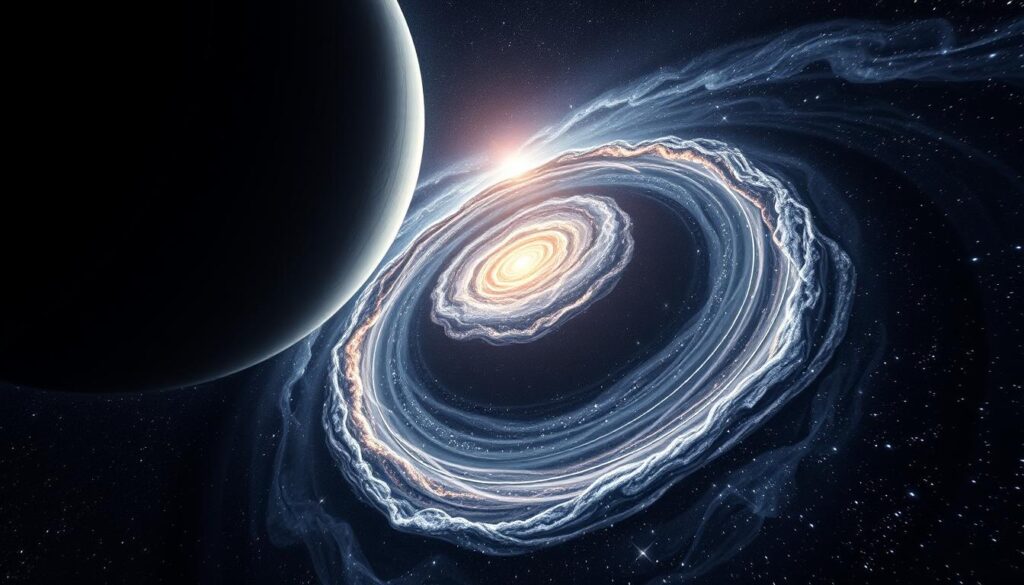
Have you ever wondered if the space around you is actually flat or mysteriously curved? The idea that space itself might bend and twist challenges everything we perceive about our physical reality. Scientists have been exploring the curvature of space-time for decades, revealing mind-bending insights that transform our understanding of the universe.
When Albert Einstein proposed his groundbreaking theory of general relativity, he introduced a revolutionary concept: space is not a rigid, unchanging backdrop but a dynamic fabric that can stretch, bend, and warp. The curvature of space-time explains phenomena that classical physics could never fully comprehend.
Your journey into understanding is space curved begins here. We’ll explore how massive objects like stars and black holes can dramatically reshape the fabric of reality. Imagine space not as an empty container, but as a flexible medium that responds to the presence of matter and energy.
Get ready to challenge your perceptions and dive into a world where space is far more complex and fascinating than you ever imagined. From gravitational waves to cosmic structures, the curvature of space-time holds secrets that continue to astound scientists and philosophers alike.
Understanding the Fundamental Nature of Space

Space is not just an empty void between objects. Modern physics reveals a complex, dynamic entity that goes far beyond our everyday perception. The spacetime fabric represents a revolutionary understanding of how the universe operates, transforming our view of reality from a static backdrop to an interactive, flexible medium.
When you explore the concept of spacetime fabric, you’ll discover a fascinating interconnection between space and time. This framework suggests that space is not rigid but a flexible, malleable substance that can stretch, bend, and warp. Physicists now understand space as a dynamic tapestry where gravitational forces create ripples and curves in its fundamental structure.
Imagine space as a giant trampoline where massive objects create depressions, influencing the movement of other objects around them. The spacetime fabric explains how planets orbit, light travels, and gravitational waves propagate. Your understanding of space shifts from a passive container to an active participant in cosmic interactions.
Scientists continue to explore the intricate properties of spacetime fabric, pushing the boundaries of our knowledge about the universe’s fundamental nature. Each discovery reveals more about how space behaves, challenging our traditional perceptions and opening new frontiers of scientific understanding.
Einstein’s General Relativity and Space Curvature

Albert Einstein revolutionized our understanding of gravity through his groundbreaking theory of general relativity. Before Einstein, scientists viewed gravity as a simple pulling force between objects. His innovative approach transformed this perspective by introducing the concept of curvature of space-time as a fundamental mechanism of gravitational interaction.
General relativity explains gravity not as a force, but as a geometric property of space and time. Imagine space-time as a flexible fabric that can stretch and bend around massive objects. When a planet or star exists in this fabric, it creates a depression – much like a bowling ball placed on a stretched rubber sheet. This curvature of space-time determines how objects move and interact.
Einstein’s theory suggests that massive celestial bodies actually warp the surrounding space-time. This warping influences the path of other objects, including light. Planets, stars, and black holes create unique gravitational landscapes that bend trajectories in ways Newton’s classical physics could never explain. The curvature of space-time provides a more accurate description of gravitational phenomena across the universe.
By reimagining gravity through the lens of space-time geometry, Einstein opened up entirely new ways of understanding cosmic interactions. His work continues to be a cornerstone of modern physics, helping scientists explore and explain complex astronomical observations.
Is Space Curved? The Scientific Evidence

Scientists have uncovered remarkable evidence supporting the concept of curved space through groundbreaking experiments and observations. Albert Einstein’s theory of general relativity predicted that gravity and space are intimately connected, fundamentally changing our understanding of the universe.
One of the most compelling pieces of evidence comes from gravitational lensing. When light from distant galaxies passes near massive objects like black holes or galaxy clusters, it bends around these objects. This phenomenon demonstrates that space is not a rigid structure but a flexible fabric that can be warped by gravitational forces.
The detection of gravitational waves in 2015 by the Laser Interferometer Gravitational-Wave Observatory (LIGO) provided another crucial validation. These ripples in spacetime, caused by massive cosmic events like black hole mergers, directly confirmed Einstein’s predictions about how is space curved and how gravity influences spatial geometry.
Astronomical observations have shown that massive celestial bodies create distinct curvatures in space. Planets, stars, and black holes all contribute to bending the fabric of spacetime around them, creating gravitational wells that affect the movement of light and matter.
These scientific discoveries continue to expand our understanding of space, revealing a universe far more complex and dynamic than previously imagined. Each new observation brings us closer to comprehending the intricate relationship between gravity and the fundamental structure of space.
The Fabric of Spacetime and Gravitational Effects

Imagine space as a flexible, stretchy fabric that can bend and warp. This concept of spacetime fabric is crucial to understanding how gravity works. When massive objects like planets or stars exist, they create a curvature in this fabric, similar to how a heavy ball would create a dip on a stretched rubber sheet.
Gravity and space are intimately connected through this dynamic relationship. The more massive an object, the more it warps the spacetime fabric around it. This warping is what we experience as gravitational pull. Light and other objects naturally follow the curves created by this fabric, which explains why light can bend around massive celestial bodies.
Scientists have discovered that spacetime is not a static entity but a dynamic, responsive medium. Gravitational waves, which are ripples in this fabric, can be created by significant cosmic events like black hole mergers. These waves travel across the universe, carrying information about the most extreme events in our cosmic neighborhood.
Understanding the spacetime fabric helps explain complex astronomical phenomena that traditional physics could not fully describe. It provides insights into how galaxies form, how planets orbit, and how energy moves through the universe.
How Massive Objects Bend Space Around Them

Imagine space as a flexible fabric that can stretch and bend. Massive objects like planets, stars, and black holes create dramatic distortions in this cosmic landscape. When an object with significant mass sits on this fabric, it creates what scientists call a gravitational well – a curved depression that changes how other objects move through space.
The curvature of space-time dramatically impacts the behavior of nearby objects. Think of a heavy bowling ball placed on a stretched rubber sheet. The ball creates a deep dip, causing smaller objects to roll toward its center. Similarly, planets and stars create gravitational wells that influence the paths of surrounding celestial bodies.
Black holes represent the most extreme example of gravity and space curvature. These cosmic giants warp space-time so intensely that not even light can escape their gravitational pull. The more massive the object, the more pronounced its ability to bend the fabric of space around it.
Understanding how massive objects interact with space helps scientists explain complex astronomical phenomena. Your perception of space shifts from a static backdrop to a dynamic, malleable environment that responds to the presence of matter. This revolutionary concept demonstrates that gravity is not just a force, but a fundamental shaping mechanism of our universe.
Light’s Journey Through Curved Space
When you explore the fascinating world of space curvature, light reveals remarkable secrets about the universe. The bending of light provides compelling evidence that space is not a flat, rigid construct but a flexible fabric that can be warped by massive objects.
Gravitational lensing demonstrates how light travels through curved space. Imagine light from distant galaxies passing near a massive object like a black hole or galaxy cluster. Instead of moving in a straight line, the light bends around the object, creating stunning visual phenomena that showcase how space itself can be curved.
Einstein’s groundbreaking theory of general relativity predicted this phenomenon long before scientists could observe it. During a solar eclipse in 1919, astronomers confirmed that light from distant stars appeared to bend around the sun’s gravitational field, providing the first experimental proof of is space curved.
Modern telescopes now routinely capture spectacular images of light bending around massive celestial objects. These observations help scientists map the invisible gravitational landscapes of our universe, revealing how spacetime curves and interacts with matter.
By studying the intricate paths of light through space, researchers continue to unravel the complex geometry of our cosmic environment, pushing the boundaries of our understanding of space and time.
The Shape of the Universe: Flat, Curved, or Open?
When you explore the mysteries of space, understanding its shape becomes a fascinating journey. Is space curved? Scientists have long pondered this question, investigating the curvature of space-time to reveal the universe’s fundamental geometry.
Researchers identify three primary universe shapes: flat, positively curved, and negatively curved. A flat universe maintains parallel lines that never intersect, suggesting a balanced cosmic structure. Positively curved universes resemble spherical surfaces, where parallel lines ultimately converge. Negatively curved spaces create a saddle-like configuration where lines gradually diverge.
Modern astronomical observations suggest our universe is remarkably close to being flat. Advanced telescopes and cosmic microwave background measurements provide crucial insights into space curvature. These studies reveal subtle variations in the universe’s geometry, challenging previous assumptions about cosmic structure.
Your understanding of space curvature helps unravel complex cosmic mysteries. While definitive conclusions remain elusive, scientists continue exploring the intricate patterns of spacetime, seeking to comprehend the grand design of our expansive universe.
Space Curvature and Time Dilation
When you explore the fascinating world of general relativity, you’ll discover how spacetime fabric fundamentally changes our understanding of time and gravity. Einstein’s groundbreaking theory reveals that gravity isn’t just a force, but a warping of space and time around massive objects.
Time dilation is a mind-bending phenomenon where time moves differently depending on gravitational fields. Imagine two identical clocks – one on Earth’s surface and another near a black hole. The clock closer to a massive object will tick more slowly due to the intense curvature of spacetime fabric.
Scientists have proven this concept through precise experiments. Atomic clocks on satellites and high-altitude aircraft demonstrate measurable time differences compared to ground-based clocks. This isn’t science fiction – it’s a real consequence of general relativity that affects everything from GPS navigation to our understanding of cosmic events.
The curvature of spacetime means gravity can actually bend time itself. Powerful gravitational fields can slow down time’s progression, creating unique scenarios where time passes at different rates for objects in different locations. This principle challenges our traditional linear view of time and space.
Measuring Space Curvature: Modern Methods
Modern scientists have developed remarkable techniques to explore the curvature of space-time. Advanced technologies now allow researchers to peer deep into the fabric of the universe, revealing how space is curved in ways never before possible.
Space-based telescopes play a crucial role in measuring space curvature. These sophisticated instruments capture light from distant galaxies, helping scientists map gravitational distortions and understand how massive objects bend the space around them. Precision atomic clocks complement these observations by detecting minute changes in time and space.
Gravitational wave detectors represent another breakthrough in understanding is space curved. These incredibly sensitive instruments can detect ripples in space-time caused by massive cosmic events like black hole collisions. Researchers use data from observatories like LIGO (Laser Interferometer Gravitational-Wave Observatory) to map the intricate landscape of space-time curvature.
Cutting-edge satellite missions continue to push the boundaries of our knowledge. Missions like the Planck space telescope have provided unprecedented insights into the large-scale structure of the universe, helping scientists create detailed maps of space curvature that challenge our traditional understanding of cosmic geometry.
Your journey into understanding space curvature is just beginning. As technology advances, we can expect even more precise measurements and profound discoveries about the fundamental nature of space and time.
Practical Applications and Future Research
Your understanding of curved space extends far beyond theoretical physics. Technologies like GPS systems rely directly on principles of general relativity to provide accurate global positioning. The precise calculations required to track satellite movements account for gravity and space curvature, ensuring pinpoint accuracy in navigation and location services.
Researchers continue exploring the frontiers of quantum gravity, seeking deeper insights into how gravity and space interact at microscopic scales. Advanced telescopes and space probes now collect unprecedented data about cosmic structures, helping scientists map the complex geometries of spacetime with increasing precision. These investigations push the boundaries of our current scientific knowledge.
Future research aims to develop a comprehensive theory that integrates quantum mechanics with general relativity. Scientists at leading institutions like CERN and NASA are developing sophisticated experiments to test complex models of space curvature. Your curiosity drives these explorations, potentially unlocking revolutionary understanding of the universe’s fundamental structure.
Emerging technologies such as quantum computing and advanced gravitational wave detectors promise to transform our comprehension of space’s intricate fabric. As researchers continue probing these cosmic mysteries, we inch closer to unraveling the profound mathematical and physical principles that govern our expansive universe.




